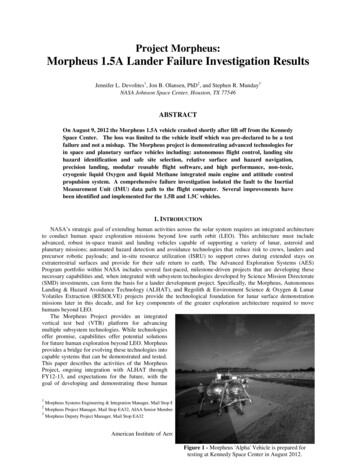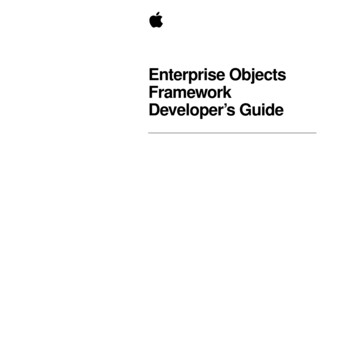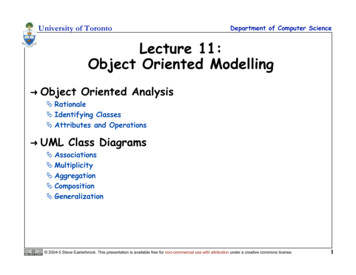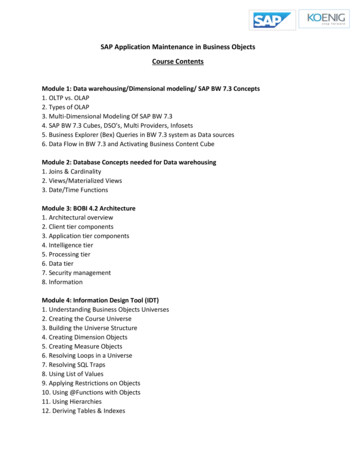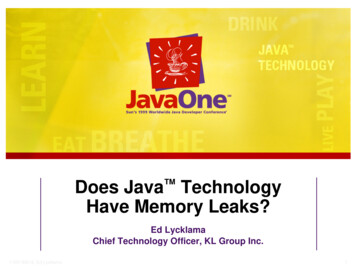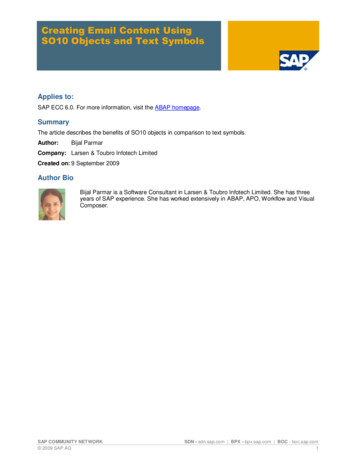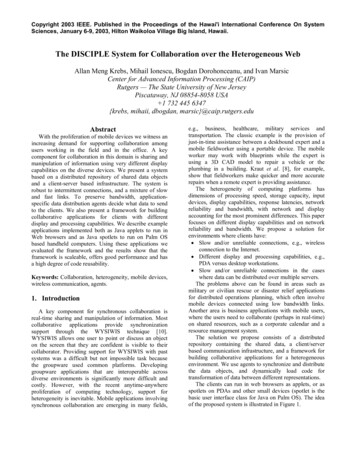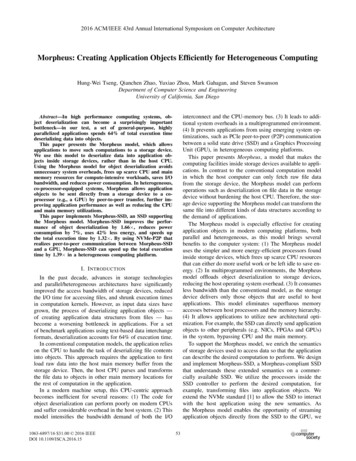
Transcription
2016 ACM/IEEE 43rd Annual International Symposium on Computer ArchitectureMorpheus: Creating Application Objects Efficiently for Heterogeneous ComputingHung-Wei Tseng, Qianchen Zhao, Yuxiao Zhou, Mark Gahagan, and Steven SwansonDepartment of Computer Science and EngineeringUniversity of California, San DiegoAbstract—In high performance computing systems, object deserialization can become a surprisingly importantbottleneck—in our test, a set of general-purpose, highlyparallelized applications spends 64% of total execution timedeserializing data into objects.This paper presents the Morpheus model, which allowsapplications to move such computations to a storage device.We use this model to deserialize data into application objects inside storage devices, rather than in the host CPU.Using the Morpheus model for object deserialization avoidsunnecessary system overheads, frees up scarce CPU and mainmemory resources for compute-intensive workloads, saves I/Obandwidth, and reduces power consumption. In heterogeneous,co-processor-equipped systems, Morpheus allows applicationobjects to be sent directly from a storage device to a coprocessor (e.g., a GPU) by peer-to-peer transfer, further improving application performance as well as reducing the CPUand main memory utilizations.This paper implements Morpheus-SSD, an SSD supportingthe Morpheus model. Morpheus-SSD improves the performance of object deserialization by 1.66 , reduces powerconsumption by 7%, uses 42% less energy, and speeds upthe total execution time by 1.32 . By using NVMe-P2P thatrealizes peer-to-peer communication between Morpheus-SSDand a GPU, Morpheus-SSD can speed up the total executiontime by 1.39 in a heterogeneous computing platform.interconnect and the CPU-memory bus. (3) It leads to additional system overheads in a multiprogrammed environment.(4) It prevents applications from using emerging system optimizations, such as PCIe peer-to-peer (P2P) communicationbetween a solid state drive (SSD) and a Graphics ProcessingUnit (GPU), in heterogeneous computing platforms.This paper presents Morpheus, a model that makes thecomputing facilities inside storage devices available to applications. In contrast to the conventional computation modelin which the host computer can only fetch raw file datafrom the storage device, the Morpheus model can performoperations such as deserialization on file data in the storagedevice without burdening the host CPU. Therefore, the storage device supporting the Morpheus model can transform thesame file into different kinds of data structures according tothe demand of applications.The Morpheus model is especially effective for creatingapplication objects in modern computing platforms, bothparallel and heterogeneous, as this model brings severalbenefits to the computer system: (1) The Morpheus modeluses the simpler and more energy-efficient processors foundinside storage devices, which frees up scarce CPU resourcesthat can either do more useful work or be left idle to save energy. (2) In multiprogrammed environments, the Morpheusmodel offloads object deserialization to storage devices,reducing the host operating system overhead. (3) It consumesless bandwidth than the conventional model, as the storagedevice delivers only those objects that are useful to hostapplications. This model eliminates superfluous memoryaccesses between host processors and the memory hierarchy.(4) It allows applications to utilize new architectural optimization. For example, the SSD can directly send applicationobjects to other peripherals (e.g. NICs, FPGAs and GPUs)in the system, bypassing CPU and the main memory.To support the Morpheus model, we enrich the semanticsof storage devices used to access data so that the applicationcan describe the desired computation to perform. We designand implement Morpheus-SSD, a Morpheus-compliant SSDthat understands these extended semantics on a commercially available SSD. We utilize the processors inside theSSD controller to perform the desired computation, forexample, transforming files into application objects. Weextend the NVMe standard [1] to allow the SSD to interactwith the host application using the new semantics. Asthe Morpheus model enables the opportunity of streamingapplication objects directly from the SSD to the GPU, weI. I NTRODUCTIONIn the past decade, advances in storage technologiesand parallel/heterogeneous architectures have significantlyimproved the access bandwidth of storage devices, reducedthe I/O time for accessing files, and shrunk execution timesin computation kernels. However, as input data sizes havegrown, the process of deserializing application objects —of creating application data structures from files — hasbecome a worsening bottleneck in applications. For a setof benchmark applications using text-based data interchangeformats, deserialization accounts for 64% of execution time.In conventional computation models, the application relieson the CPU to handle the task of deserializing file contentsinto objects. This approach requires the application to firstload raw data into the host main memory buffer from thestorage device. Then, the host CPU parses and transformsthe file data to objects in other main memory locations forthe rest of computation in the application.In a modern machine setup, this CPU-centric approachbecomes inefficient for several reasons: (1) The code forobject deserialization can perform poorly on modern CPUsand suffer considerable overhead in the host system. (2) Thismodel intensifies the bandwidth demand of both the I/O1063-6897/16 31.00 2016 IEEEDOI 10.1109/ISCA.2016.1553
also implement NVMe-P2P (an extension of Donard [2])that provides peer-to-peer data exchange between MorpheusSSD and the GPU.The Morpheus programming model is simple. Programmers write code in C or C to perform computationssuch as deserialization in the storage device. The Morpheuscompiler generates binaries for both the host computer andthe storage device and inserts code to allow these two typesof binaries to interact with each other.Our initial implementation of Morpheus-SSD improvesobject deserialization from text files by 66%, leading toa 32% improvement in overall application performance.Because Morpheus-SSD does not rely on CPUs to convertdata into objects, Morpheus-SSD reduces the CPU load,eliminates 97% of context switches, and saves 7% of totalsystem power or 42% of energy consumption during objectdeserialization. With Morpheus-SSD, applications can enjoythe benefit of P2P data transfer between an SSD and a GPU:this increases application performance gain to 39% in aheterogeneous computing platform. The performance gain ofusing Morpheus-SSD is more significant in slower servers—Morpheus-SSD can speed up applications by 2.19 .Although this paper only demonstrates using theMorpheus-SSD model for deserialization objects from textfiles, we can apply this model to other input formats (e.g.binary inputs) as well as other kinds of interactions betweenmemory objects and file data (e.g. serialization or emittingkey-value pairs from flash-based key-value store [3]).This paper makes the following contributions: (1) Itidentifies object deserialization as a useful application forcomputing inside modern, high-performance storage devices. (2) It presents the Morpheus model, which providesa flexible general-purpose programming interface for objectdeserialization in storage. (3) It demonstrates that in-storageprocessing model, like the Morpheus model, enables newopportunities of architectural optimizations (e.g. PCIe P2Pcommunications) for applications in heterogeneous computing platforms. (4) It describes and evaluates Morpheus-SSD,a prototype implementation of the Morpheus model, madeusing commercially available components.The rest of this paper is organized as follows: Section IIdescribes the current object deserialization model and thecorresponding performance issues. Section III provides anoverview of the Morpheus execution model. Section IVintroduces the architecture of Morpheus-SSD. Section Vdepicts the programming model of Morpheus. Section VIdescribes our experimental platform. Section VII presentsour results. Section VIII provides a summary of related workto put this project in context, and Section IX concludes thepaper. Figure 1.(a) (b)Object deserialization in conventional modelssystem may use flash-based SSDs as the file storage. Thesystem may also include GPU accelerators that containthousands of Arithmetic Logic Units (ALUs) to providevectorized parallelism. These SSDs and GPUs connect withthe host computer system through the Peripheral ComponentInterconnect Express (PCIe) [4] interconnect. These SSDscommunicate using standards including Serial AdvancedTechnology Attachment (Serial ATA or SATA) [5] or NVMExpress (NVMe) [6] [1]. These standards allow the hostcomputer to issue requests to the storage device, includingreads, writes, erases, and some administrative operations.To exchange, transmit, or store data, some applications usedata interchange formats that serialize memory objects intoASCII or Unicode text encoding (e.g. XML, CSV, JSON,TXT, YAML). Using these text-based encodings for datainterchange brings several benefits. For one, it allows machines with different architectures (e.g. little endian vs. bigendian) to exchange data with each other. These file formatsallow applications to create their own data objects that betterfit the computation kernels without requiring knowledge ofthe memory layout of other applications. These text-basedformats also allow users to easily manage (e.g. compareand search) the files without using specific tools. However,using data from these data interchange formats also resultsin the overhead of deserializing application objects, since itrequires the computer to convert data strings into machinebinary representations before generating in-memory datastructures from these binary representations.Figure 1 illustrates the conventional model (Figure 1(a))and the corresponding data movements (Figure 1(b)) for deserializing application objects. The application begins objectdeserialization by requesting the input data from the storagedevice as in phase A of Figure 1(a). After the storage devicefinishes reading the content of the input file, the storagedevice sends the raw data to the main memory through theI/O interconnect, resulting in the data transfer from the SSDto the main memory buffer X as in arrow (1) of Figure 1(b).In application phase B of Figure 1(a), the application loadsthe input data from the main memory (data transfer (2) inFigure 1(b)), converts the strings into binary representations,and stores the resulting object back to another location in themain memory (data transfer (3) from the CPU to memorylocation Y in Figure 1(b)). The program may repeat phasesA and B several times before retrieving all necessary data.II. D ESERIALIZING APPLICATION OBJECTSA typical computer system contains one or more processors with DRAM-based main memory and stores thebulk data as files in storage devices. Because of SSDs’high-speed, low-power, and shock-resistance features, the54
Other CPU computationDeserializationNormalized execution time1hard drive. The NVMe SSD can sustain more than 2 GB/secbandwidth and the hard drive provides 158 MB/sec bandwidth. We create a 16GB RAM drive using the host systemDRAM attached to a DDR3 memory bus that theoreticallycan offer up to 12.8 GB/sec bandwidth.Figure 3 reports the effective bandwidth of object deserialization for each I/O thread in these applications. In thispaper, we define the effective bandwidth as the memory sizeof application objects that the system can produce within asecond. Compared to the traditional magnetic hard drive, theNVMe SSD delivers 5% higher effective bandwidth whenusing a 2.5 GHz Xeon processor. However, the performanceof the RAM drive is essentially no better than the NVMeSSD. If we under-clock the CPU to 1.2 GHz, we observedsignificant performance degradation. However, the performance differences among different storage devices remainmarginal.This result indicates that CPU code is the bottleneckwhen systems with high-speed storage devices deserializeobjects from files. In other words, if we use the conventionalmodel for object deserialization in these applications, theapplication does not take advantage of higher-speed storagedevices, even those as fast as a RAM drive.Executing object deserialization on the CPU is expensive. To figure out the source of the inefficiency, we profilethe code used to parse a file of ASCII-encoded strings intoan array of integers. The profiling result shows that the CPUspent only 15% of its time executing the code of convertingstrings to integers. The CPU spent the most of the rest of itstime handling file system operations including locking filesand providing POSIX guarantees.The conventional approach to object deserialization alsoresults in increased context switch overhead. In the conventional approach, applications must access the storage deviceand the memory many times when deserializing objects. As aresult, the system must frequently perform context switchesbetween kernel spaces and different processes since fetchingdata from the storage device or accessing memory data canlead to system calls or latency operations. For example, ifa memory access in phase B of Figure 1(a) misses in thelast-level cache or if the memory buffer in phase B needs tofetch file content, the system may switch to the kernel spaceto handle the request from the application.Object deserialization performs poorly on CPUs. Tofurther investigate the potential of optimizing the object deserialization code, we implemented a function that maintainsthe same interface as the original primitive but bypassesthese overheads. Eliminating these overheads speeds upfile parsing by 1.74 . However, the instruction-per-cycle(IPC) of the remaining code, which examines the bytearrays storing the input strings and accumulates the resultingvalues, is only 1.2. This demonstrates that decoding ASCIIstrings does not make wise use of the rich instruction-levelparallelism inside a CPU core.Deserializing objects using CPUs wastes bandwidth andGPU/CPU Data CopyGPU Kernels0.80.60.40.2Figure 2.Effective Bandwidth ortgaussianbfsCCPageRank0The overhead of object deserialization in selected applicationsNVMe SSD w/ 2.5GHz CPURamDrive w/ 2.5GHz CPUHDD w/ 2.5GHz CPUNVMe SSD w/ 1.2GHz CPURamDrive w/ 1.2GHz CPUHDD w/ 1.2GHz gaussianbfsCCPageRank0Figure 3. The effective bandwidth of object deserialization in selectedapplications using different storage devices under different CPU frequenciesFinally, the CPU or the graphics accelerator on an APU(Accelerated Processing Unit (APU) [7] can start executingthe computation kernel which consumes the applicationobjects in the main memory as in phase C (data transfer(4) loading data from memory location Y in Figure 1(b)). Ifthe application executes the computation kernel on a discreteGPU (use phase C’ instead of C), the GPU needs to load allobjects from the main memory before the GPU kernel canbegin (hidden lines of Figure 1).Because of the growing size of input data and intensiveoptimizations in computation kernels, deserializing application objects has become a significant performance overhead.Figure 2 breaks down the execution time of a set ofapplications that use text-based encoding as their input data.(Section VI provides more details about these applicationsand the testbed.) With a high-speed NVMe SSD, theseapplications still spend 64% of their execution time deserializing objects. To figure out the potential for improvingthe conventional object deserialization model, we performdetailed experiments in these benchmark applications andobtain the following observations:Object deserialization is CPU-bound.To examine thecorrelation between object deserialization and the speed ofstorage devices, we execute the same set of applications andload the input data from a RAM drive, an NVMe SSD, or a55
memory. The conventional object deserialization modelalso creates unnecessary traffic on the CPU-memory busand intensifies main memory pressure in a multiprogrammedenvironment.Deserializing objects from data inputs requires memoryaccess to the input data buffer and the resulting objectlocations as shown in phases A and B of Figure 1(a) andsteps (2)–(3) in Figure 1(b). When the computation kernelbegins (phase C of Figure 1(a)), the CPU or a heterogeneouscomputing unit (e.g. the GPU unit of an APU) needs toaccess deserialized objects. This results in memory accessesto these objects again. Since the computation kernel doesnot work directly on the input data strings, storing the rawdata in the memory creates additional overhead in a multiprogrammed environment. For APU-based heterogeneouscomputing platforms in which heterogeneous types of processors share the same processor-memory bus, these memoryaccesses can lead to contentions and degrade performanceof bandwidth hungry GPU applications [8] [9].Since text-based encoding usually requires more bytesthan binary representation, the conventional model mayconsume larger bandwidth to transport the same amountof information compared to binary-encoded objects. Forexample, the number “12345678” requires at least 8 bytesin ASCII code, but only needs 4 bytes using 32-bit binaryrepresentation.Conventional object deserialization prevents applicationsfrom using emerging optimizations in heterogeneouscomputing platforms.Many systems support P2Pcommunication between two endpoints in the same PCIeinterconnect, bypassing the CPU and the main memoryoverhead ][22][2]. the conventional model restricts the usage ofthis emerging technique in applications. Applications thatstill rely on the CPU-centric object deserialization modelto generate vectors for GPU kernels must go throughevery step in Figure 1(b), but cannot directly send datafrom the SSD to the GPU. This model also creates hugetraffic in the system interconnect and CPU-memory busas it exchanges application objects between heterogeneouscomputing resources.In the rest of the paper, we will present and evaluatethe Morpheus model that addresses the above drawbacksof deserializing objects in the conventional computationmodel. Figure 4.(a) (b)Object deserialization in using the Morpheus modelcompliant storage device (in this paper, the Morpheus-SSD)and invokes a StorageApp, a user-defined program that theunderlying storage device can execute. After the storagedevice fetches the raw file from its storage medium, thestorage device does not send it to the host main memoryas it would in the conventional model. Instead, the storagedevice executes the StorageApp to create binary objects asthe host application requests. Finally, the storage devicesends these binary objects to the host main memory (or thedevice memory of heterogeneous computing resources (e.g.the GPU)), and the computation kernel running on the CPUor GPU (phase C or phase C’) can use these objects withoutfurther processing.Figure 4(b) illustrates the data movements using theMorpheus model. Because the system leverages the storagedevice for object deserialization, the storage device onlyneeds to deliver the resulting application objects to thesystem main memory as in step (1), eliminating the memorybuffer (location X in Figure 1(b)) and avoiding the CPU–memory round-trips of steps (2)–(3) in Figure 1(b).By removing the CPU from object deserialization, thismodel achieves several benefits for the system and theapplication:Improving power, reducing energy, allowing more efficient use of system resources: The Morpheus modelallows applications to use more energy-efficient embeddedprocessors inside the storage device, rather than more powerhungry high-end processors. This reduces the energy consumption required for object deserialization. The Morpheusmodel improves resource utilization in the CPU by eliminating the low-IPC object deserialization code and allowing theCPU to devote its resources to other, higher-IPC processesand applications. In addition, if the system does not havemore meaningful workloads, the host processor can operatein low-power model to further reduce power.Bypassing system overhead: The Morpheus model executes StorageApp directly inside the storage device. Therefore, StorageApp is not affected by the system overheadsof running applications on the host CPU, including locking,buffer management, and file system operations. In addition,due to the low-ILP nature of object deserialization, even withthe embedded cores inside a modern SSD, the Morpheusmodel can still deliver compelling performance.Mitigating system overheads in multiprogrammed en-III. T HE MORPHEUS MODELIn contrast to the conventional model, in which the CPUprogram retrieves raw file data from the storage device tocreate application objects, the Morpheus model can transform files into application objects and send the result directlyto the host computer from the storage device and minimizesthe intervention from the CPU.Figure 4(a) depicts the Morpheus execution model. To begin deserializing objects for the host application, the application provides the location of the source file to the Morpheus-56
vironments: In addition to freeing up CPU resources forother workloads, this model can also mitigate context switchoverheads since it does not require the CPU to perform anyoperation until the end of a StorageApp. By eliminating thememory buffers for raw input data (memory location X inFigure 1(b)), the Morpheus model also relieves pressure onmain memory and reduces the number of page faults inmultiprogrammed environments.Reducing traffic in system interconnects:Since theMorpheus model removes the host-side code of object deserialization, this model also eliminates the memory operationsthat load raw data and store the converted objects to the mainmemory in the conventional model (phase B in Figure 1(a)and steps (2)–(3) in Figure 1(b)). As a result, the Morpheusmodel can reduce the traffic on the CPU–memory bus.This is especially helpful for APU-based systems, in whichheterogeneous computing resources compete for space andbandwidth for the same main memory.In the interconnect that moves data among peripherals,the Morpheus-compliant storage device can send applicationobjects to the rest of the system that are more condensed thantext strings. Therefore, the Morpheus model also reducesthe amount of data transferred over the I/O interconnect. Ifthe final destination of objects is the main memory, we canfurther reduce the size of data going through the memorybus.Enabling more efficient P2P communication for heterogeneous computing applications: The PCIe interconnectallows P2P communication between two peripherals; SSDscan support this mechanism through re-engineering thesystem as NVMMU [21], GPUDrive [22], Donard [2], or (inthis paper) NVMe-P2P. However, if the application needs togenerate application objects using the CPU and stores theseobjects in the main memory, supporting P2P communicationbetween the SSD and the GPU will not help applicationperformance.With the Morpheus model, the storage device can generateapplication objects using the StorageApp. It can then directlysend these objects (as in Step (5) of Figure 4(b)), bypassingthe CPU and the main memory overhead. Therefore, theMorpheus model allows more opportunities for applicationsto reduce traffic in system interconnects, as well as to reduceCPU loads, main memory usage, and energy consumption.This is not possible in the conventional model as theapplication cannot bypass the CPU. !" "'" # % ! # & ! # Figure 5. !" The system architecture of Morpheus-SSDFigure 5 depicts the system architecture that supportsthe Morpheus model. We implement Morpheus-SSD, anSSD that provides new NVMe commands to execute StorageApps, by extending a commercially available NVMeSSD. For software to utilize Morpheus-SSD, we extendthe NVMe driver and develop a runtime system that provides an interface for applications. With the runtime systemtranslating application demands into NVMe commands, theextended NVMe driver can set up the host system resourceand communicate the Morpheus-SSD through the PCIeinterconnect. As the Morpheus model eliminates the hostCPU from object deserialization, this model also allows fora more efficient data transfer mechanism. To demonstratethis benefit, the system also implements NVMe-P2P, allowing Morpheus-SSD to directly exchange data with a GPUwithout going through the host CPU and the main memoryin a heterogeneous computing platform.In the following paragraphs, we will describe the set ofNVMe extensions, the design of Morpheus-SSD and theimplementation of NVMe-P2P in detail.A. NVMe extensionsNVMe is a standard that defines the interaction betweena storage device and the host computer. NVMe providesbetter support for contemporary high-speed storage usingnon-volatile memory than conventional standards designedfor mechanical storage devices (e.g. SATA). NVMe containsa set of I/O commands to access the data and admin commands to manage I/O requests. NVMe encodes commandsinto 64-byte packets and uses one byte inside the commandpacket to store the opcode. The latest NVMe standarddefines only 14 admin commands and 11 I/O commands,allowing Morpheus-SSD to add new commands in this onebyte opcode space.To support the Morpheus model, we define four newNVMe commands. These new commands enrich the semantics of an NVMe SSD by allowing the host application toexecute a StorageApp and transfer the application objectto/from an NVMe storage device. These new commands are:This command initializes the execution of aMI NIT:StorageApp in a Morpheus-SSD. The MI NIT commandcontains a pointer, the length of the StorageApp code, and aIV. T HE SYSTEM ARCHITECTUREAs the Morpheus model changes the role of storagedevices in applications—deserializing objects in addition toconventional data access operations—we need to re-engineerthe hardware and system software stacks. On the hardwareside, the storage device needs to support new semanticsthat allow its own processing capability to be tapped fordeserializing application objects. The system software alsoneeds to interface with the application and the hardware toefficiently utilize the Morpheus model.57
the embedded cores based on ARM [23] or MIPS architectures [24] and the DRAM to maintain the flash translationlayer (FTL) that maps logical block addresses to physicalchip addresses. The firmware programs that maintain theFTL also periodically reclaim free space for later dataupdates. Each embedded core contains instruction SRAM (ISRAM) and data SRAM (D-SRAM) to provide instructionand data storage for the running program. The SSD uses theflash interface to interact with NAND flash chip arrays whenaccessing data.To handle these new NVMe commands and execute theuser-defined StorageApps, we re-engineer the NVMe/PCIeinterface and firmware programs running on the embeddedcores inside the Morpheus-SSD. Because these new NVMecommands share the same format with existing NVMecommands, the modifications to the NVMe interface areminor. We only need to let the NVMe interface recognize theopcode and instance ID of these new commands and deliverthe command to the corresponding embedded cores. Thecurrent Morpheus-SSD implementation delivers all packetswith the same instance ID to the same core.The process of executing a StorageApp on the designated embedded core goes as follows. After receiving aMI NIT command, the firmware program first ensures thatthe StorageApp code resides in the I-SRAM. The runningStorageApp works on the D-SRAM data and moves data inor out of D-SRAM upon the requests of subsequent MR EADor MW RITE commands. As with conventional read/writecommands, the StorageApp uses the in-SSD DRAM tobuffer the DMA data between Morpheus-SSD and otherdevices.The Morpheus-SSD leverages the existing read/write process and the FTL of the baseline SSD to manage the flashstorage, except when processing data after fetching datafrom the flash array or other devices. Morpheus-SSD alsouses the fast locking mechanism from the SSD hardwaresupport to ensure data integrity. These firmware programsmaintain and support existing features for conventionalNVMe commands without sacrificing performance or guarantees. Since the Morpheus model does not alter the contentof storage data, Morpheus-SSD performs no changes to theFTL of the baseline SSD. Figure 6.The architecture of an NVMe SSDlist of arguments from the host application. This commandalso carries an instance ID that allows the Morpheus-SSD todifferentiate StorageApp requests from different host systemthreads.MR EAD : This command acts like a conventional NVMeread operation, except that it reads data from the SSD tothe embedded core and then uses a StorageApp (selectedaccording to the instance ID specified by the commandpacket) to process that data and send it back to the host.MW RITE :This command is similar to the MR EAD,but works for writing data to the SSD, again using aStorageApp (selected according the instance ID specified bythe command packet) to process the writing data and sendit back to the host.MD EINIT: This command completes the execution of aStorageApp. Upon receiving this command, the MorpheusSSD releases SSD memory of the corresponding StorageAppinstance. The StorageApp can use the completion messageto send a return value to the host application.These commands follow the same packet format as conventional NVMe commands: each command uses 40 bytesfor the header and 24 bytes for the payload.B. The design of Morpheus-S
Finally, the CPU or the graphics accelerator on an APU (Accelerated Processing Unit (APU) [7] can start executing the computation kernel which consumes the application objects in the main memory as in phase C (data transfer (4) loading data from memory location Y in Figure 1(b)). If the application executes the computation kernel on a discrete
